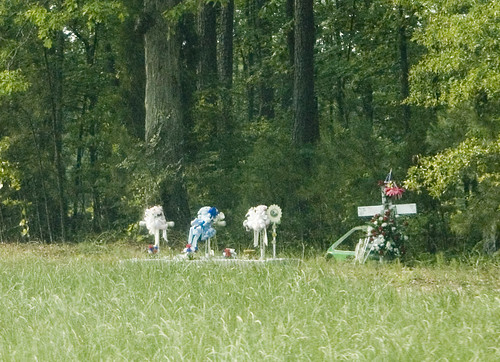On Wednesday I had to make one of my many treks down the road for a meeting in Columbia. At mile marker 93 on Interstate 26, just north of Columbia, I pass a sight I’ve seen many times – a rather elaborate roadside memorial in the southbound lane. On July 24, 2000, a north-bound vehicle crossed the median and hit a van, killing eight passengers, including six members of the Odom family from Asheville, North Carolina. It was a terrible tragedy, and prompted the state to pass legislation requiring cable barriers installed in all grass medians on South Carolina’s Interstate highways.
Over the years I’ve watched this memorial change. It started as a set of simple crosses, and has grown to include flowers, and now even has a bright green door panel from some vehicle. At one point the smaller crosses representing the children of the family sported T-shirts. Someone obviously maintains the site, and is careful to make sure there are always flowers of some kind.
I cannot begin to imagine the grief that such a tragedy would cause. However, my own limited point of view finds some of this behavior odd. Dressing crosses in t-shirts? One must wonder when the line is crossed from remembering the dead to pathology.
In addition to the Odom Family’s, there are other memorials along this stretch of highway. Most are just a simple cross marking the location of a fatality. Some are maintained with flowers. According to USA Today…
Once an occasional sight along the nation’s highways, roadside memorials have sprouted in recent years like wildflowers after spring rains. There were 42,800 traffic fatalities in the USA last year. No statistics exist on memorials, though one national survey this year by the Maryland Department of Transportation estimates markers are erected after 10% to 20% of fatal crashes.
Family and friends increasingly want to mark the spot, and that can be a problem for everything from motorist safety to road maintenance to those who oppose religious symbols on public land.
"I don’t want to bother anybody, but that cross is there for us. No one else. When I go by it, it gives me peace," says Carter-Lane, 44. Her son, Anthony Carter, was killed on Oct. 14, 2003, when his car slammed into a truck near Clearwater. Carter-Lane came upon the crash less than 10 minutes after it occurred. Her husband planted the cross the next day.
Roadside memorials were once most common in the Southwest, where they evolved from centuries-old Catholic traditions in Spain and Mexico. Now, they’re everywhere — from rural Wyoming, where school kids designed the state’s official memorial sign, to New York City, where artists install white "ghost bikes" at the site of deadly bicycle crashes.
South Carolina doesn’t have any laws regarding roadside memorials, but that’s not the case across the nation. When we were in Florida over spring break, I noticed that they have a state-sanctioned sign to mark fatality sites. It’s a circular sign with the words "Drive Safely." Other states such as Colorado have also moved to something that is standardized and secular in nature. Some states have banned the practice outright.
It seems to me that there is a safety issue. If that particular stretch of road is hazardous to drive, then it’s also probably hazardous for someone to maintain a memorial. One memorial that I spotted in a neighborhood street was actually on the edge of someone’s lawn. That would bring up all kinds of potential conflicts between the homeowner and the aggrieved family. To make matters worse, there was a For Sale sign in front of the house. I can just imagine how that adds to the appeal of the house.
I am of mixed feelings. I personally do not find the memorials offensive. Some I’ve seen look trashy because that aren’t maintained. And there are the safety issues I’ve already mentioned. Some are quite interesting, and some people spend time seeking out and documenting these. To move to something standardized would take away from the personalization and interest, but it might also cut down on a potentially unhealthy obsession with the site of a loved one’s death.
Here lies John Jay,
Who died maintaining his right-of-way.
He was right, dead right as he barrelled along,
But he’s just as dead as if he were wrong.Burma Shave
